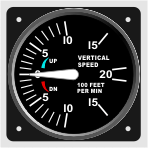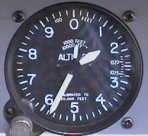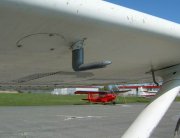 The rate-of-climb indicator, also called the vertical-speed indicator or VSI, is one of six instruments in the standard instrument cluster familiar to airplane pilots. It reports the rate at which the airplane’s altitude is changing, in hundreds of feet per minute. (Interesting fact: in an unpressurized airplane cabin, a comfortable rate of descent is five hundred feet per minute. Much more than that and passengers will begin to feel ear pain from the pressure changes. So a pilot flying 5,000 feet above the elevation of his or her destination should begin descending while still ten minutes away from the airfield.)
The rate-of-climb indicator, also called the vertical-speed indicator or VSI, is one of six instruments in the standard instrument cluster familiar to airplane pilots. It reports the rate at which the airplane’s altitude is changing, in hundreds of feet per minute. (Interesting fact: in an unpressurized airplane cabin, a comfortable rate of descent is five hundred feet per minute. Much more than that and passengers will begin to feel ear pain from the pressure changes. So a pilot flying 5,000 feet above the elevation of his or her destination should begin descending while still ten minutes away from the airfield.)
The VSI does not need a power source. It doesn’t need to be wound or filled or set. There are no tubes, wires, gears, levers, or lines of any kind leading to or from it. It just sits there, bolted into the instrument panel, requiring nothing but some clear space around it for air to flow freely. How can it possibly work?
 The altimeter, another standard instrument, is much easier to understand. It registers the airplane’s height above sea level by measuring the ambient air pressure. (Interesting fact: the ambient air pressure runs to the altimeter through a tube originating at a tiny hole in the skin of the plane called the “static port.” An airplane in flight affects the pressure of the air all around it; the static port is strategically placed where the effect on the surrounding air pressure is neutral.) Air pressure decreases at a pretty constant rate the higher you go, so if you know the pressure at sea level (a setting that changes from place to place and from hour to hour — pilots periodically get the setting from a radio broadcast and adjust a knob on the altimeter), and you know the air pressure, then you know your altitude. The altimeter is nothing but a funny-looking barometer calibrated in feet above sea level.
The altimeter, another standard instrument, is much easier to understand. It registers the airplane’s height above sea level by measuring the ambient air pressure. (Interesting fact: the ambient air pressure runs to the altimeter through a tube originating at a tiny hole in the skin of the plane called the “static port.” An airplane in flight affects the pressure of the air all around it; the static port is strategically placed where the effect on the surrounding air pressure is neutral.) Air pressure decreases at a pretty constant rate the higher you go, so if you know the pressure at sea level (a setting that changes from place to place and from hour to hour — pilots periodically get the setting from a radio broadcast and adjust a knob on the altimeter), and you know the air pressure, then you know your altitude. The altimeter is nothing but a funny-looking barometer calibrated in feet above sea level.
 Even the airspeed indicator, which is a bit cleverer, is easy to understand. It uses two sources of air pressure: the “static” air pressure (from the aforementioned static port), and the “ram” air pressure, which is the pressure of the oncoming air as measured by a tube (the “pitot” tube, rhymes with Frito) pointing forward. Via some simple plumbing, the static pressure is subtracted from the ram pressure and the result is shown on the airspeed dial, calibrated in knots or in miles per hour.
Even the airspeed indicator, which is a bit cleverer, is easy to understand. It uses two sources of air pressure: the “static” air pressure (from the aforementioned static port), and the “ram” air pressure, which is the pressure of the oncoming air as measured by a tube (the “pitot” tube, rhymes with Frito) pointing forward. Via some simple plumbing, the static pressure is subtracted from the ram pressure and the result is shown on the airspeed dial, calibrated in knots or in miles per hour.
The design of the VSI is a whole ’nother level of cleverness. For a long time I tried to puzzle it out myself before I finally relented and looked up the answer. Can you figure it out?
Inside the VSI there are two empty chambers. The chambers are separated from each other by a thin, flexible membrane. Separately, both chambers also have holes through which air can flow in and out.
One chamber’s hole is big. When the airplane climbs and the surrounding air gets thinner, some of the air in that chamber exits through the big hole very quickly to equalize the pressure.
The other chamber’s hole is tiny. When the airplane climbs, some of the air in that chamber exits through the tiny hole very slowly. Thus, for a brief time (until the second chamber equalizes), the pressure in the two chambers is different, forcing the membrane to flex, bulging into the first chamber. The faster the plane climbs, the greater is the difference in pressure between the two chambers, and the more the membrane flexes.
When the airplane descends, the first chamber fills with additional air faster than the second chamber and the membrane flexes the other way.
The needle of the VSI is connected to the flexible membrane, directly registering the rate of climb or descent. Eventually, when the plane returns to level flight and the air pressure stops changing, the membrane returns to its normal shape and the needle points to 0.
Brilliant.
If it had been up to me to design a VSI it would be electrical. It would involve a timer circuit or some sort of clockwork mechanism so that altitude readings could be taken at regular intervals. The difference between successive readings would be displayed on the dial. It would be vulnerable to electrical failure and mechanical breakdown.
I am in awe of the simple design of the real VSI.